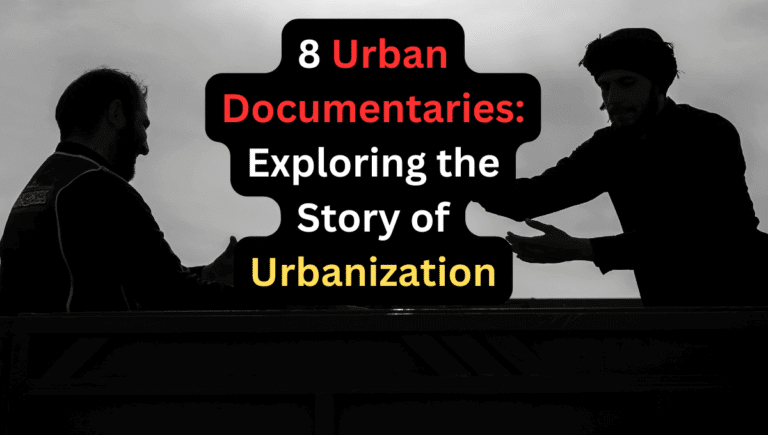Being a city dweller, I have always been fascinated by the hustle and bustle of urban life. The chaos, diversity, and vibrancy that make up every metropolis have always intrigued me. And what better way to explore the story of urbanization than through documentaries?
Documentaries are a powerful medium to educate, inspire and entertain. They offer a unique perspective on complex issues and dive deep into the real-life stories that shape our world.
The Urban Tapestry: An Excursion Into 8 Engrossing Documentaries
In this blog post, I will introduce you to 8 urban documentaries that capture the essence of urbanization and urban environments in all its glory. As someone who thrives amidst the sounds and scenery of city life, urban landscapes have an irresistible allure for me. With every corner echoing a unique rhythm, cities present a compelling blend of diversity, dynamism, and a bit of delightful disorder.
1. The Human Scale
“The Human Scale” the first documentary on our list, delves into Danish architect Jan Gehl’s ideology. Cities should be designed for people, not cars. He believes that urbanization and city planning should focus on nurturing social interaction among its population.
Throughout the film, we traverse cities across the globe, witnessing firsthand the consequences of rapid urbanization and the potential for transformation when cities prioritize human-scale design.
This documentary not only challenges our perspective on urban design but urges viewers to question it.
How can our cities be better suited for a quality life?
How can urbanization foster not hinder human connection?
It’s a compelling watch for anyone interested in urbanization and the creative stories that emerged from the 19th century.
2. The Human Element
Shot in nine states across America, photographer James Balog captures the human impact on our environment through breathtaking photographs. This documentary explores how urbanization and industrialization have transformed Earth’s natural landscapes and climate over the years.
The images of melting glaciers, flooded cities and raging wildfires are a poignant reminder that we need to rethink the way we build cities to coexist with nature. “The Human Element” is an eye-opening documentary that showcases the human toll of urbanization and the importance of sustainable development.
3. Urbanized
Directed by Gary Hustwit, “Urbanized” offers a global perspective on city planning and its impact on people’s lives (everyday life). The film features interviews with some of the world’s top urban planners, architects, and policymakers as they discuss the challenges of building cities that are livable, sustainable, and equitable.
From the slums of Mumbai to the bike-friendly streets of Copenhagen, this documentary showcases diverse approaches to urbanization and the creative solutions that emerge from them.
4. The Pruitt-Igoe Myth
“The Pruitt-Igoe Myth” tells the story of a public housing project in St. Louis, Missouri that was touted as the future of urban living but ultimately became a symbol of failure.
Through interviews with former residents and archival footage, this documentary delves into the social and political factors that led to the downfall of Pruitt-Igoe.
It also sheds light on how urbanization can both uplift and marginalize communities, and the importance of community involvement in shaping urban development.
5. Paris is Burning
“Paris is Burning” showcases the vibrant and creative underground ballroom scene in New York City during the 1980s. The film explores the lives of the predominantly black and Latino LGBTQ+ participants who use these balls to express themselves, break free from societal norms, and find a sense of belonging.
Beyond being a celebration of diversity and self-expression, “Paris is Burning” provides a glimpse into the struggles and discrimination faced by these communities in urban spaces or maybe in ancient cities.
6. Citizen Jane: Battle for the City
In the 1960s, urban activist Jane Jacobs took on Robert Moses, New York’s powerful city planner who was responsible for several large-scale urban development projects.
This documentary tells the story of the epic battle between Jacobs and Moses, as well as the impact it had on urbanization and city planning. It also raises important questions about the balance between progress and preservation in cities.
7. The End of Suburbia
“The End of Suburbia” examines the unsustainable nature of suburban living and its potential consequences in a world facing resource depletion and climate change. The film challenges the idea of suburban living as the “American Dream” and explores alternative solutions for sustainable urban living.
It serves as a wake-up call to reexamine our reliance on automobile-dependent suburbs and the need for more compact, walkable cities.
8. My Brooklyn
Through the lens of gentrification, “My Brooklyn” explores how rapid economic development can have devastating effects on the cultural fabric of a neighborhood. The documentary follows the transformation of Brooklyn’s historic African-American and Caribbean community into a trendy, upscale zone, displacing long-time residents and local businesses in the process.
“My Brooklyn” sheds light on the complex issues surrounding urban development and its impact on marginalized communities.
How Do Documentaries Increase Thrill?
Documentaries, particularly those revolving around urban themes of American Cities city living, have the power to evoke emotions, provoke thought, and spark impactful conversations. They serve as thrilling windows into distinct, real-world narratives.
Here’s how they manage to do so:
- Unearthing Hidden Stories: Urban documentaries reveal lesser-known creative stories, bringing to light life’s often ignored aspects. They present an unfiltered view of reality that can be both enlightening and gripping.
- Provoking Emotions: These films possess the ability to invoke a vast spectrum of emotions. From the struggle for preservation in “Citizen Jane: Battle for the City” to the cultural upheaval depicted in “My Brooklyn”, they engage viewers on a deep, emotional level.
- Inspiring Change: Urban documentaries prompt viewers to reconsider their perceptions of urbanization. Films like “The End of Suburbia” encourage rethinking suburban living and promote sustainable alternatives. This call to action creates a sense of urgency and thrill.
- Exposing Inequality: They expose social and economic disparities inherent in urban development. By highlighting these inequalities, these documentaries instill a sense of justice and ignite the desire for change.
- Educational Yet Engaging: These films aren’t just informative; they’re captivating. They weave facts and narratives together into a compelling format that piques viewer interest and fosters learning in an engaging manner.
- Resonating with Authenticity: Documentaries are a medium that stays true to the stories they portray, making them a powerful tool for shedding light on urban issues. By showcasing the reality of urban life, these films connect with viewers in an authentic manner.
- Arousing Curiosity: Urban documentaries continually challenge our preconceived notions about cities and expose us to new perspectives. They spark curiosity in viewers, encouraging them to dive deeper into the complex issues surrounding urbanization.
- Empowering Voices: These films give a voice to those often overlooked in society and provide a platform for marginalized communities to share their stories. By amplifying these voices, they empower individuals and promote social change.
Conclusion:
As an avid fan of urban documentaries, I have been captivated by the power of these films to inform and inspire. They not only provide valuable knowledge but also ignite a sense of curiosity and desire for social change. Through the creative use of storytelling, urban documentaries shed light on pressing urban issues and expose viewers to diverse perspectives.

